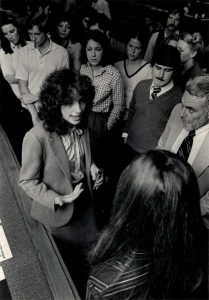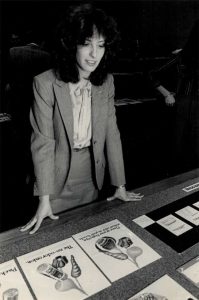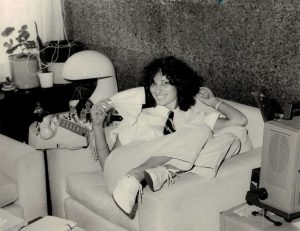How to Put Your Book Together and get a Job in Advertising
 Buy the Book:
Buy the Book:Amazon
Published by: W. W. Norton & Company; Newly Revised edition
Release Date: August 30, 2010
Pages: 256
ISBN13: 978-0393732856
Overview
This is a true story about a self-published trade paperback book that did not earn me much, if anything but has paid me back in ways I never imagined.
In 1979, I was a recruiter at Foote, Cone, and Belding, a large national ad agency based in New York City. I worked for the executive creative director, filling creative department jobs: copywriters, art directors, and TV producers. One part of my job was to interview beginners and find new talent. We even had a training program for this new talent to be placed in our offices from New York to California. I was tasked with discovering the best kids.
Universities were offering Communications, P.R., and Advertising classes, but it seemed that most educators had never worked in an advertising agency. However, their classrooms were always packed to the walls. Advertising was called a glamour business back then. I was overwhelmed with requests for interviews, and for the most part, the "kids" didn't know what advertising professionals wanted to see in their portfolios -- called a "book" -- of sample ads.
I taught some night classes and traveled to ad schools in other cities. One day, I decided to write a primer book for all those kids with degrees in Communications who had no idea how to present advertising samples or even get an interview.
It took me eight months to write a seventy-page trade paperback book called "How To Put Your Book Together and Get a Job in Advertising." Giff Crosby, a copywriter with a knack for creating clever line drawings, illustrated the book with cartoon characters, and senior art director Billy Foster designed the cover. I asked a dozen ad agency pros to each write an essay for a section of the book called “A Little Help From Some Friends.” Ed Buxton, a savvy gentleman who published Ad Day, an industry-wide newsletter, said he would financially back the production of this little book. He did that and more. He told me that I was a writer.
Sometime later, "How To" was delivered to my inbox. It was a skinny little book designed to look like a portfolio. I remember thinking that it looked awfully small, but it had legs. Ed took the book out "under his arm" and went to the Barnes and Noble purchasing department, where they placed an order. Within a year, Ed had his $5,000 back. We now had a sales record, and when Ed took “How To,” an imprint of a large publisher, he sold it -- and educators and creative directors recommended it. That happened before the computer age, and that small indie book has been in print since 1979.
Later, "How To" was supplemented and reprinted through four editions, the last time in 2010. I received a royalties statement last year telling me that in 2022, twenty copies were sold. Never mind that tiny number. I didn't know that the book was still in print! Yesterday, I got a letter from a 68-year-old "kid" named Dave who'd read "How To" in the 80's. He put his book together and got a job in advertising, and he is still in advertising today. He wanted to share the good news!
Dave isn't the first or only former college grad who was looking for a job in 1980 to write or call me in the 2020s. I never imagined that that soft-cover, self-published book would have such a long journey, how many people would successfully use it, or how glad I am that I put that little book together.



Praise
“The complete how-to book of the decade….”
“Great. Maxine answers every conceivable question and then some… I strongly recommend this book to all my students.”
–Richard Wilde, Co-Chairman Media Arts, School of Visual Arts
“Read this book before you go to ad school. Max Paetro’s advice is timeless."
–Betsy Yamazaki, EVP, Creative Manager Lowe, New York
“When I wanted to be a copywriter, How To Put Your Book Together was my ‘Bible.’ I remember lying on my parent’s couch reading this book, wondering how I was going to get the attention of that elusive creative recruiter. Now that I am one myself, I know what all my candidates are going through. So it’s great to know that the “How-to Bible’ is still here to guide them, just as it did me.”
–Michele Daly Bozell, New York
“Maxine Paetro makes a long overdue contribution to the agency world… hers is no stuffy, professorial tome. Instead, it’s a conversationally written, witty primer on the agency hiring ABCs.”
– The New York Daily News
“There are two ways to embark on a career in advertising: One, buy Maxine Paetro’s book. Two, buy a helmet. Number one is cheaper, faster and smart.”
–Ed McCabe Hall of Fame Copywriter
“Having run the ad industry’s largest, longest-running creative training program, I may hold the world record for hiring entry-level writers and art directors. I surely hold the record for recommending this book! If you’re lucky enough to have a ticket to one of the great portfolio schools, read this book; if not, read it over and over again.”
– Flinn Dallis, SVP, Director of Creative Operations, Leo Burnett Company, USA
“Paetro’s book is timeless… one of the classics of advertising brain building that reminds us there are no real rules, a few valuable guidelines, and lots of great common sense to take to heart if you want to make it as a creative.”
– Professor Deborah Morison, University of Texas
“The unfortunate pilgrim, driving in the big city, can heed her guidelines in all aspects of job hunting… this book offers a positive and supportive attitude to those struggling with the bewildering prospect of the hunt.”
– Advertising Techniques
“This is a remarkable book. It speaks directly to the young person for whom the message is intended.”
– Ron Seichrist, Miami Ad School
“Max is terrific! The book is an invaluable tool for young people starting in the creative side of the business – full of important tips that could make the difference in their approach to job interviews.”
– Judy Wald – The Judy Wald Agency
“ You know those rare books that you read that actually change you and the way you think, and you’re never the same because it helps you grow and improve and gives you insight to a whole new way of ‘being’… well, this is one of those books.”
– Amazon Review
“Buy this book. Max Paetros’s up-to-the-minute classic is still the only book that dares to tell the whole gory truth about how to get into advertising.”
– Jim Patterson, Former Chairman, JWT North America, Worldwide Creative Director, Best-Selling Author
“This book reads like a long, interesting chalk talk from one of advertising’s great coaches, Maxine really knows what it takes to get a creative director’s attention.”
– Andrew Jaffe, AdWeek/The Clio Awards
“It’s a fabulous book. A great resource for someone who’s trying to get into the business or someone who’s already in the business and trying to do better work.”
– Sandy Wade, The Sandy Wade Company
“It took me seven years to find a job as a copywriter. If this book were around in those days, I’m egotistical enough to believe it would have taken only seven days.”
– Jerry Della Femina, CEO, Chief Creative Director, Della Femina, Rothschild, Jeary and Partners
“This is the book that started it all for me. Max’s book was so great, so insightful, so essential that it answered questions I didn’t even know I was supposed to have!”
– Amy Krouse Rosenthal, the WOW Workshop
“The most stolen book from our library.”
– Chicago Public Library
The Award-Winning Advertising Career Classic New and Improved for the 21st Century: Endorsed by advertising professionals and portfolio schools across the country – with advice from top creatives at BBDO, Chiat/Day, TBWA, Fallon, Cliff Freeman, Goodby Silverstein & Partners, Kirshenbaum & Bond, JWT, O&M, Wieden + Kennedy, Y&R, and more.
Excerpt
Introduction:
This book was not written by a copywriter, an art director, or a creative director. It was written by me, Maxine Paetro, a creative department manager, a recruiter, an administrator, whose job it was for many years to be concerned with the quality of life in an advertising agency creative department.
I have never written a word of advertising copy.
What I have done during my 20-plus years in advertising is hire or recommend to be hired a lot of copywriters and art directors. While doing that, I saw many, many thousands of books.
I wish I could, but I can’t actually teach you how to become a copywriter or an art director. (I assume you have decided on an advertising career and have taken courses in advertising.)
My purpose with this book is to help you become aware of what makes a great ad, help you think through the advertising process, give you some guidelines on how to present your work in the best possible light, assist you in getting to and impressing people who’ve seen as many portfolios as I’ve seen, and help you land a job.
The original How to Put Your Book Together… grew out of talks I’d given to students at art schools and universities
This newest edition picks up from those talks and continues with questions asked by new generations of future advertising people.
As before, the questions are those of copy and art students. The answers are mine. I have kept the basic information in this revision: first-year issues concerning concepts and campaigns for those who have just begun to ask what this portfolio is all about.
I have added new questions and answers that I hope will help those about to graduate, those who are about to enter or have already entered the tougher-than-ever entry-level job competition.
Because I am but one voice in the wilderness, I’ve invited some of the best creative brains in advertising to express their point of view about the business, tell what they look for in a portfolio, and generally offer you a helping hand. You’ll find these contributions in the third section of this book.
Finally, it is important to understand that there are often no wrong or right answers in a business as subjective as advertising.
But I think you will agree, and you have to know the rules to break them.
My hope is that you will incorporate the advice you get from this book with what you believe is right for you and, in the process, form your own good judgment.
If you can do that, you will have a better chance of getting your first job in advertising.